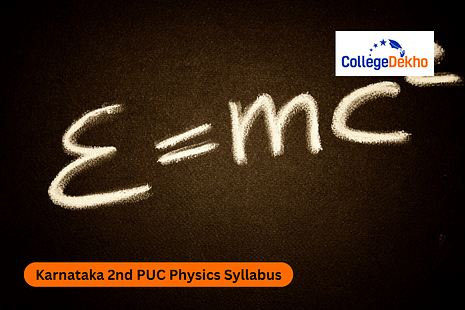

Never Miss an Exam Update
Karnataka 2nd PUC Physics Syllabus 2026 includes 10 units. These units are further divided into 14 chapters. The theory paper in Physics will be conducted for 70 marks, and the remaining marks are allotted for a practical. You need to study the syllabus in detail to successfully prepare for the board exams. Some topics are also eliminated from the syllabus according to the latest changes made to the curriculum by KSEAB. You also need to understand the detailed Karnataka 2nd PUC Physics Exam Pattern 2026 to prepare well.
After completing the syllabus, do not forget to practice the Karnataka 2nd PUC Physics Model Paper 2026 . Check out more information about the Karnataka 2nd PUC Physics Syllabus 2026 here:
Karnataka 2nd PUC Physics Course Content 2026
You can refer to the new course content for Karnataka 2nd PUC Physics Syllabus 2026 from the table given below. The marks include questions with internal choices also:
Unit Sr. No. | Chapter/Content Domain/Theme | No. of Periods | Marks |
|---|---|---|---|
I | Electric Charges & Fields | 12 | 11 |
II | Electrostatic Potential and Capacitance | 12 | 10 |
III | Current Electricity | 15 | 13 |
IV | Moving Charges and Magnetism | 13 | 11 |
V | Magnetism and Matter | 6 | 5 |
Electromagnetic Induction | 8 | 7 | |
VI | Alternating Current | 8 | 7 |
Electromagnetic Waves | 3 | 3 | |
VII | Ray Optics and Optical Instruments | 11 | 10 |
VIII | Wave Optics | 8 | 7 |
IX | Dual Nature of Radiation and Matter | 6 | 5 |
Atoms | 4 | 4 | |
X | Nuclei | 5 | 4 |
Semiconductor Electronics | 9 | 8 | |
Total | 120 | 105 |
Also Read: Karnataka 2nd PUC Physics Previous Year Question Paper
Karnataka 2nd PUC Physics Chapter-Wise Syllabus 2026
Refer to the detailed Karnataka 2nd PUC Physics Chapter-Wise Syllabus 2026 here:
Part I
Chapters | Topics |
|---|---|
Chapter 1: Electric Charges and Fields | 1.1 Introduction 1.5 Basic Properties of Electric Charge 1.6 Coulomb’s Law 1.7 Forces between Multiple Charges 1.8 Electric Field 1.9 Electric Field Lines 1.10 Electric Flux 1.11 Electric Dipole 1.12 Dipole in a Uniform External Field 1.13 Continuous Charge Distribution 1.14 Gauss’s Law 1.15 Applications of Gauss’s Law 1.15.1 Field due to infinitely long straight uniformly charged wire. 1.15.2 Field due to uniformly charged infinite plane sheet. |
Chapter 2: Electrostatic Potential and Capacitance | 2.1 Introduction 2.2 Electrostatic Potential 2.3 Potential due to a Point Charge 2.4 Potential due to an Electric Dipole 2.5 Potential due to a System of Charges 2.6 Equipotential Surfaces 2.7 Potential Energy of a System of Charges 2.8 Potential Energy in an External Field 2.9 Electrostatics of Conductors 2.10 Dielectrics and Polarisation 2.11 Capacitors and Capacitance 2.12 The Parallel Plate Capacitor 2.13 Effect of Dielectric on Capacitance 2.14 Combination of Capacitors |
Chapter 3: Current Electricity |
3.1 Introduction
3.5 Drift of Electrons and the Origin of
|
Chapter 4: Moving Charges and Magnetism | 4.1 Introduction 4.2 Magnetic Force 4.3 Motion in a Magnetic Field 4.4 Motion in Combined Electric and Magnetic Fields 4.5 Magnetic Field due to a Current Element, Biot-Savart Law 4.6 Magnetic Field on the Axis of a Circular Current Loop 4.7 Ampere’s Circuital Law 4.8 The Solenoid and the Toroid 4.9 Force between Two Parallel Currents, the Ampere 4.10 Torque on Current Loop, Magnetic Dipole 4.11 The Moving Coil Galvanometer |
Chapter 5: Magnetism and Matter | 5.1 Introduction 5.2 The Bar Magnet 5.2.1 The magnetic field lines 5.3 Magnetism and Gauss’s Law 5.4 The Earth’s Magnetism 5.5 Magnetisation and magnetic intensity |
Chapter 6: Electromagnetic Induction |
6.1 Introduction
6.4 Faraday’s Law of Induction
6.9 Inductance 6.10 AC Generator |
Chapter 7: Alternating Current | 7.1 Introduction 7.2 AC Voltage Applied to a Resistor 7.3 Representation of AC Current and Voltage by Rotating Vectors — Phasors 7.4 AC Voltage Applied to an Inductor 7.5 AC Voltage Applied to a Capacitor 7.6 AC Voltage Applied to a Series LCR Circuit 7.9 Transformers |
Chapter 8: Electromagnetic Waves | 8.1 Introduction 8.3 Electromagnetic Waves 8.4 Electromagnetic Spectrum |
Part II
Chapters | Topics |
|---|---|
Chapter 9: Ray Optics and Optical Instruments | 9.1 Introduction 9.4 Total Internal Reflection 9.5Refraction at Spherical Surfaces and by Lenses 9.6 Refraction through a Prism 9.8 Optical Instruments (except resolving power microscope and astronomical telescope) |
Chapter 10: Wave Optics | 10.1 Introduction 10.2 Huygens Principle 10.3 Refraction and Reflection of Plane Waves using Huygens Principle 10.4 Coherent and Incoherent Addition of Waves |
Chapter 11: Dual Nature of Radiation and Matter | 11.1 Introduction 11.2 Electron Emission 11.3 Photoelectric Effect 11.4 Experimental Study of Photoelectric Effect 11.5 Photoelectric Effect and Wave Theory of Light 11.6 Einstein’s Photoelectric Equation: Energy Quantum of Radiation 11.7 Particle Nature of Light: The Photon 11.8 Wave Nature of Matter |
Chapter 12: Atoms | 12.1 Introduction Experiment 12.2 Alpha particle Scattering and Rutherford’s Nuclear Model of Atom 12.3 Atomic Spectra 12.6 De Broglie’s Explanation of Bohr’s Secon d Postulate of Quantisation |
Chapter 13: Nuclei | 13.1 Introduction 13.2 Atomic Masses and Composition of Nucleus 13.3 Size of the Nucleus 13.4 Mass Energy and Nuclear Binding Energy (except binding energy per nucleon and its variation with the mass number) 13.5 Nuclear Force 13.7 Nuclear Energy |
Chapter 14: Semiconductor Electronics: Material Devices and Simple Circuits | 14.1 Introduction 14.2 Classification of Metals, Conductors and Semiconductors 14.3 Intrinsic Semiconductor 14.4 Extrinsic Semiconductor |
Karnataka 2nd PUC Physics Reduced Syllabus 2026
Refer to the table below to learn about the topics that are deleted for the academic year 2026:
Part I
Chapters | Deleted Topics |
|---|---|
Chapter 1: Electric Charges and Fields | 1.2 Electric Charge (delete only activity with paper strips and making 1.3 Conductors and Insulators (delete only 1.4 Charging by InductionExercises 1.13, 1.25–1.34 |
Chapter 2: Electrostatic Potential and Capacitance | 2.15 Energy Stored in a Capacitor (delete only derivation) Exercises 2.12 to 2.36 |
Chapter 3: Current Electricity | 3.7 Resistivity of Various Materials (delete Tables 3.1 and 3.2 and Carbon resistors, Colour code for carbon resistor 3.10 Combinations of Resistors – Series and Parallel Example 3.5 3.15 Meter Bridge 3.16 Potentiometer Exercises 3.3, 3.4, 3.10, 3.12, 3.14–3.23 |
Chapter 4: Moving Charges and Magnetism | Table 4.1 4.4.1 Velocity Selector 4.4.2 Cyclotron 4.8.2 The Toroid 4.10.3 The Magnetic Dipole Moment of a Revolving Electron Exercises 4.14–4.28 |
Chapter 5: Magnetism and Matter | 5.2.2 Bar Magnet as an Equivalent Solenoid (delete only mathematical treatment) 5.2.3 The Dipole in a Uniform Magnetic Field (delete only mathematical treatment) Example 5.4 5.4 Earth’s Magnetism 5.41. Magnetic Declination and Dip Table 5.2 5.6.2 Paramagnetism 5.6.3 Ferromagnetism temperature; and Hysteresis 5.7 Permanent Magnets and Electromagnets Exercises 5.1, 5.2, 5.9–5.11, 5.13–5.25 |
Chapter 6: Electromagnetic Induction | 6.7 Energy Consideration: A Quantitative Study 6.8 Eddy Currents Exercises 6.6, 6.10–6.17 |
Chapter 7: Alternating Current | Figure 7.7 Magnetisation and Demagnetisation of an Inductor Figure 7.10 Charging and Discharging of a Capacitor 7.6.2 Analytical Solution 7.6.3 Resonance (delete only Sharpness of Resonance) 7.8 LC Oscillations Exercises 7.6, 7.8, 7.10, 7.12–7.26 |
Chapter 8: Electromagnetic Waves | Example 8.1 8.3.2 Nature of Electromagnetic Waves (delete only about ether and page 277) Examples 8.4 and 8.5 Exercises 8.11–8.15 |
Part II
Chapters | Topics |
|---|---|
Chapter 9: Ray Optics and Optical Instruments | 9.3 Refraction (delete only advanced sunrise and delayed sunset) 9.7 Some Natural Phenomena Due to Sunlight 9.7.1 The Rainbow 9.7.2 Scattering of Light Exercise 9.18 |
Chapter 10: Wave Optics | 10.3.4 Doppler Effect Example 10.1 10.5 Interference of Light waves and Young’s experiment (retain the final expressions for dark and bright fringes but delete the derivation; delete expression for fringe width) 10.6 Diffraction (retain only qualitative treatment) 10.6.3 Resolving Power of Optical Instruments 10.6.4 Validity of Ray Optics 10.7.1 Polarisation by Scattering 10.7.2 Polarisation by Exercises 10.7–10.21 |
Chapter 11: Dual Nature of Radiation and Matter | Table 11.1 Example 11.3 11.8 Wave Nature of Matter (delete only derivation for de Broglie wavelength of accelerated electron; and Heisenberg’s uncertainty principle) 11.9 Davisson and Germer Experiment Appendix 11.1 The History of Wave-Particle Flip-Flop Exercises 11.5, 11.7, 11.12 to 11.14, 11.16, 11.17, 11.19–11.37 |
Chapter 12: Atoms | 12.3.1 Spectral Series 12.4 Bohr Model of the Hydrogen Atom (retain only the expression for radius of nth possible orbit but delete its derivative) 12.5 The Line Spectra of the Hydrogen Atom (retain only qualitative treatment) Example 12.6 Exercises 12.3, 12.11–12.17 |
Chapter 13: Nuclei | 13.6.1 Law of Radioactive Decay 13.6.2 Alpha Decay 13.6.3 Beta Decay 13.6.4 Gamma Decay 13.7.2 Nuclear Reactor Exercises 13.1, 13.2, 13.6–13.10, 13.12–13.14, 13.18, 13.22–13.31 |
Chapter 14: Semiconductor Electronics: Material Devices and Simple Circuits | 14.8 Special Purpose p-n junction Diodes 14.9 Digital Electronics and Logic Gates Exercises 14.7–14.15 |
You can refer to the Karnataka 2nd PUC Physics Syllabus 2026 mentioned above to successfully prepare for the exam. Make sure to have proper knowledge about the deleted topics.
Are you feeling lost and unsure about what career path to take after completing 12th standard?
Say goodbye to confusion and hello to a bright future!

FAQs
Karnataka 2nd PUC Physics Syllabus 2026 is divided into 10 units, each with in-depth topics and subtopics.
The latest Karnataka 2nd PUC Physics Syllabus 2026 has not yet been released by the Karnataka Board however students can still use previous years’ syllabus PDF to prepare for the board exams since no new changes will be recorded.
No new changes will be recorded in the Karnataka 2nd PUC Physics Syllabus 2026. However, last year a few topics were deleted from the syllabus for which the information was published on the official website of Karnataka Board so the students must take care of those topics and not study them.
KSEAB has not yet released the official PDF of the Karnataka 2nd PUC Physics Syllabus 2026. As soon as the syllabus is released, it will be available on the official website of the Karnataka School Examination and Assessment Board to be downloaded under the syllabus option present on the home page.
Karnataka 2nd PUC Physics Syllabus 2026 includes chapters like Electric Charges and Fields, Electrostatic Potential and Capacitance, Current Electricity, Moving Charges and Magnetism, Magnetism and Matter, Electromagnetic Induction, Alternating Current, and Electromagnetic Waves from Part 1 and Ray Optics and Optical Instruments, Wave Optics, Dual Nature of Radiation and Matter, Atoms, Nuclei, Semiconductor Electronics, and Communication Systems from Part 2.
The Karnataka 2nd Physics Exam 2026 will include MCQs/objective-type questions, short answer questions, and long answer questions. 35% of the total marks will be allotted to knowledge, 29% to understanding, 20% to application and 16% to HOTS.
Was this article helpful?


















